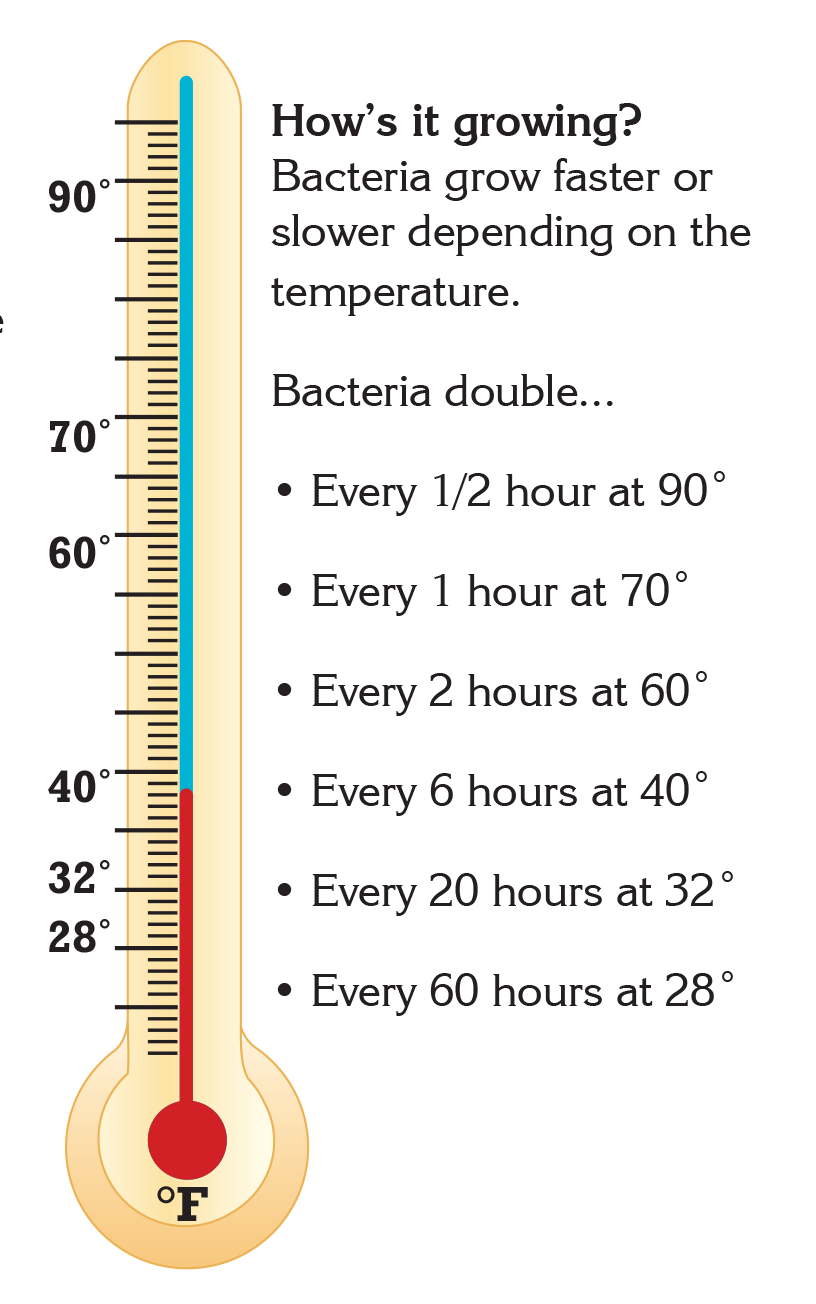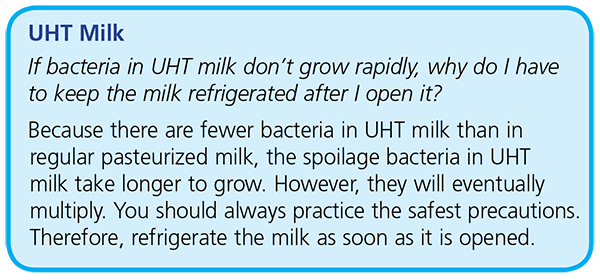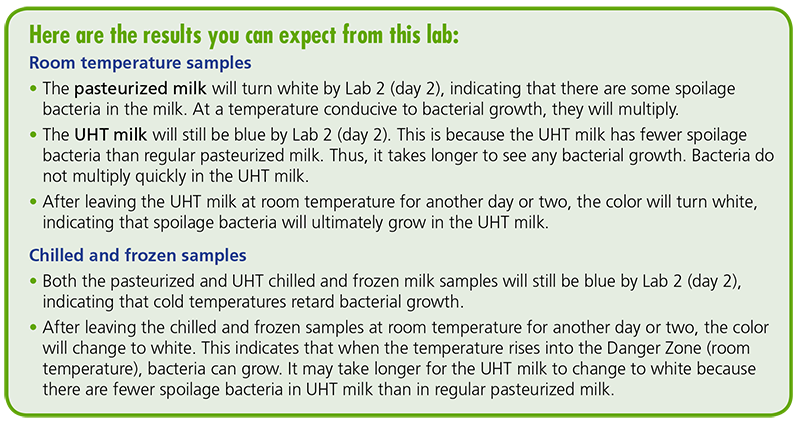Blue's the Clue: Souring Milk for Science (Grades 6-8)
This lab introduces students to the effect temperature has on reducing and controlling the growth of bacteria. Students will use conventionally pasteurized and ultra-high-temperature (UHT) milk to observe how different temperatures (hot, room temperature, cool, and freezing) affect the growth of spoilage bacteria. They will also learn about the importance of pasteurization in keeping food safe.

Background
Lesson Activities
Recommended Companion Resources
Credits
Author
Food and Drug Association (FDA) and National Science Teaching Association (NSTA)
Acknowledgements
The Science and Our Food Supply Curriculum was brought to you by the Food and Drug Administration Center for Food Safety and Applied Nutrition and the National Science Teaching Association.
- FDA Education Team Leader Food Safety Initiative: Marjorie L. Davidson
- FDA Science and Our Food Supply Project Director: Louise H. Dickerson
- FDA/NSTA Associate Executive Director and Science and Our Food Supply Program Director: Christina Gorski
- FDA/NSTA Science and Our Food Supply Program Assistant: Jill Heywood
Option B of the lab activity was adapted by Debra Spielmaker and Utah Agriculture in the Classroom.
Sources
Standards
Texas Content Area Standards
-
Investigating Careers: 7/8.127.2.c.1
The student investigates one or more careers within the 16 career clusters.
- Investigating Careers: 7/8.1.A: The student is expected to identify the various career opportunities within one or more career clusters.
-
Career and College Exploration: 127.2.d.1
The student takes one or more career interest surveys, aptitude tests, or career assessments and explores various college and career options. The student is expected to:
- Career and College Exploration: 127.2.d.1.C: identify various career opportunities within one or more career clusters.
- Career and College Exploration: 127.2.d.1.D: research and evaluate emerging occupations related to career interest areas.
-
Principles of Agriculture, Food, and Natural Resources: 130.2.c.1
The student demonstrates professional standards/employability skills as required by business and industry. The student is expected to:
- Principles of Agriculture, Food, and Natural Resources: 130.2.c.1.C: demonstrate knowledge of personal and occupational safety, environmental regulations, and first-aid policy in the workplace.
-
Principles of Agriculture, Food, and Natural Resources: 130.2.c.6
The student demonstrates appropriate personal and communication skills. The student is expected to:
- Principles of Agriculture, Food, and Natural Resources: 130.2.c.6.A: demonstrate written and oral communication skills appropriate for formal and informal situations such as prepared and extemporaneous presentations.
- Principles of Agriculture, Food, and Natural Resources: 130.2.c.6.B: demonstrate effective listening skills appropriate for formal and informal situations.
-
Principles of Agriculture, Food, and Natural Resources: 130.2.c.7
The student applies appropriate research methods to agriculture, food, and natural resources topics. The student is expected to:
- Principles of Agriculture, Food, and Natural Resources: 130.2.c.7.C: describe scientific methods of research.
-
Principles of Agriculture, Food, and Natural Resources: 130.2.c.13
The student describes the principles of food products and processing systems. The student is expected to:
- Principles of Agriculture, Food, and Natural Resources: 130.2.c.13.A: evaluate food products and processing systems.
- Principles of Agriculture, Food, and Natural Resources: 130.2.c.13.C: discuss current issues in food production.
- Principles of Agriculture, Food, and Natural Resources: 130.2.c.13.D: use tools, equipment, and personal protective equipment common to food products and processing systems.
-
ELA: 6.110.22.b.1
Developing and sustaining foundational language skills: listening, speaking, discussion, and thinking- oral language. The student develops oral language through listening, speaking, and discussion.
- ELA: 6.1.C: The student is expected to give an organized presentation with a specific stance and position, employing eye contact, speaking rate, volume, enunciation, natural gestures, and conventions of language to communicate ideas effectively.
- ELA: 6.1.D: The student is expected to participate in student-led discussions by eliciting and considering suggestions from other group members, taking notes, and identifying points of agreement and disagreement.
-
ELA: 7.110.23.b.1
Developing and sustaining foundational language skills: listening, speaking, discussion, and thinking- oral language. The student develops oral language through listening, speaking, and discussion.
- ELA: 7.1.D: The student is expected to engage in meaningful discourse and provide and accept constructive feedback from others.
-
ELA: 8.110.24.b.1
Developing and sustaining foundational language skills: listening, speaking, discussion, and thinking- oral language. The student develops oral language through listening, speaking, and discussion.
- ELA: 8.1.D: The student is expected to participate collaboratively in discussions, plant agendas with clear goals and deadlines, set time limits for speakers, take notes, and vote on key issues.
-
Social Studies: 6.113.18.c.21
Social studies skills. The student communicates in written, oral, and visual forms. The student is expected to:
- Social Studies: 6.113.18.c.21.C: express ideas orally based on research and experiences
-
Science: 6.112.26.b.1
Scientific and engineering practices. The student, for at least 40% of instructional time, asks questions, identifies problems, and plans and safely conducts classroom, laboratory, and field investigations to answer questions, explain phenomena, or design solutions using appropriate tools and models. The student is expected to:
- Science: 6.112.26.b.1.B: use scientific practices to plan and conduct descriptive, comparative, and experimental investigations and use engineering practices to design solutions to problems
- Science: 6.112.26.b.1.D: use appropriate tools such as graduated cylinders, metric rulers, periodic tables, balances, scales, thermometers, temperature probes, laboratory ware, timing devices, pH indicators, hot plates, models, microscopes, slides, life science models, petri dishes, dissecting kits, magnets, spring scales or force sensors, tools that model wave behavior, satellite images, hand lenses, and lab notebooks or journals;
- Science: 6.112.26.b.1.E: collect quantitative data using the International System of Units (SI) and qualitative data as evidence;
-
Science: 6.112.26.b.2
Scientific and engineering practices. The student analyzes and interprets data to derive meaning, identify features and patterns, and discover relationships or correlations to develop evidence-based arguments or evaluate designs. The student is expected to:
- Science: 6.112.26.b.2.B: analyze data by identifying any significant descriptive statistical features, patterns, sources of error, or limitations;
- Science: 6.112.26.b.2.C: use mathematical calculations to assess quantitative relationships in data; and
- Science: 6.112.26.b.2.D: evaluate experimental and engineering designs.
-
Science: 6.112.26.b.4
Scientific and engineering practices. The student knows the contributions of scientists and recognizes the importance of scientific research and innovation on society. The student is expected to:
- Science: 6.112.26.b.4.C: research and explore resources such as museums, libraries, professional organizations, private companies, online platforms, and mentors employed in a science, technology, engineering, and mathematics (STEM) field to investigate STEM careers.
-
Science: 6.112.26.b.5
Recurring themes and concepts. The student understands that recurring themes and concepts provide a framework for making connections across disciplines. The student is expected to:
- Science: 6.112.26.b.5.A: identify and apply patterns to understand and connect scientific phenomena or to design solutions;
- Science: 6.112.26.b.5.B: identify and investigate cause-and-effect relationships to explain scientific phenomena or analyze problems;
-
Science: 7.112.27.b.1
Scientific and engineering practices. The student, for at least 40% of instructional time, asks questions, identifies problems, and plans and safely conducts classroom, laboratory, and field investigations to answer questions, explain phenomena, or design solutions using appropriate tools and models. The student is expected to:
- Science: 7.112.27.b.1.A: ask questions and define problems based on observations or information from text, phenomena, models, or investigations;
- Science: 7.112.27.b.1.B: use scientific practices to plan and conduct descriptive, comparative, and experimental investigations and use engineering practices to design solutions to problems;
- Science: 7.112.27.b.1.D: use appropriate tools such as graduated cylinders, metric rulers, periodic tables, balances, scales, thermometers, temperature probes, laboratory ware, timing devices, pH indicators, hot plates, models, microscopes, slides, life science models, petri dishes, dissecting kits, magnets, spring scales or force sensors, tools that model wave behavior, satellite images, hand lenses, and lab notebooks or journals;
- Science: 7.112.27.b.1.E: collect quantitative data using the International System of Units (SI) and qualitative data as evidence;
-
Science: 7.112.27.b.2
Scientific and engineering practices. The student analyzes and interprets data to derive meaning, identify features and patterns, and discover relationships or correlations to develop evidence-based arguments or evaluate designs. The student is expected to:
- Science: 7.112.27.b.2.B: analyze data by identifying any significant descriptive statistical features, patterns, sources of error, or limitations;
- Science: 7.112.27.b.2.C: use mathematical calculations to assess quantitative relationships in data; and
- Science: 7.112.27.b.2.D: evaluate experimental and engineering designs.
-
Science: 7.112.27.b.4
Scientific and engineering practices. The student knows the contributions of scientists and recognizes the importance of scientific research and innovation on society. The student is expected to:
- Science: 7.112.27.b.4.C: research and explore resources such as museums, libraries, professional organizations, private companies, online platforms, and mentors employed in a science, technology, engineering, and mathematics (STEM) field to investigate STEM careers
-
Science: 7.112.27.b.5
Recurring themes and concepts. The student understands that recurring themes and concepts provide a framework for making connections across disciplines. The student is expected to:
- Science: 7.112.27.b.5.A: identify and apply patterns to understand and connect scientific phenomena or to design solutions;
- Science: 7.112.27.b.5.B: identify and investigate cause-and-effect relationships to explain scientific phenomena or analyze problems;
-
Science: 8.112.28.b.1
Scientific and engineering practices. The student, for at least 40% of instructional time, asks questions, identifies problems, and plans and safely conducts classroom, laboratory, and field investigations to answer questions, explain phenomena, or design solutions using appropriate tools and models. The student is expected to:
- Science: 8.112.28.b.1.A: ask questions and define problems based on observations or information from text, phenomena, models, or investigations;
- Science: 8.112.28.b.1.B: use scientific practices to plan and conduct descriptive, comparative, and experimental investigations and use engineering practices to design solutions to problems;
- Science: 8.112.28.b.1.D: use appropriate tools such as graduated cylinders, metric rulers, periodic tables, balances, scales, thermometers, temperature probes, laboratory ware, timing devices, pH indicators, hot plates, models, microscopes, slides, life science models, petri dishes, dissecting kits, magnets, spring scales or force sensors, tools that model wave behavior, satellite images, weather maps, hand lenses, and lab notebooks or journals;
- Science: 8.112.28.b.1.E: collect quantitative data using the International System of Units (SI) and qualitative data as evidence;
-
Science: 8.112.28.b.2
Scientific and engineering practices. The student analyzes and interprets data to derive meaning, identify features and patterns, and discover relationships or correlations to develop evidence-based arguments or evaluate designs. The student is expected to:
- Science: 8.112.28.b.2.B: analyze data by identifying any significant descriptive statistical features, patterns, sources of error, or limitations;
- Science: 8.112.28.b.2.C: use mathematical calculations to assess quantitative relationships in data; and
- Science: 8.112.28.b.2.D: evaluate experimental and engineering designs.
-
Science: 8.112.28.b.4
Scientific and engineering practices. The student knows the contributions of scientists and recognizes the importance of scientific research and innovation on society. The student is expected to
- Science: 8.112.28.b.4.C: research and explore resources such as museums, libraries, professional organizations, private companies, online platforms, and mentors employed in a science, technology, engineering, and mathematics (STEM) field to investigate STEM careers.
-
Science: 8.112.28.b.5
Recurring themes and concepts. The student understands that recurring themes and concepts provide a framework for making connections across disciplines. The student is expected to:
- Science: 8.112.28.b.5.A: identify and apply patterns to understand and connect scientific phenomena or to design solutions;
- Science: 8.112.28.b.5.B: identify and investigate cause-and-effect relationships to explain scientific phenomena or analyze problems;
-
Environmental Systems: 112.50.c.1
Scientific and engineering practices. The student, for at least 40% of instructional time, asks questions, identifies problems, and plans and safely conducts classroom, laboratory, and field investigations to explain phenomena or design solutions using appropriate tools and models. The student is expected to:
- Environmental Systems: 112.50.c.1.G: develop and use models to represent phenomena, systems, processes, or solutions to engineering problems
-
Math: 8.111.28.b.1
Mathematical process standards. The student uses mathematical processes to acquire and demonstrate mathematical understanding. The student is expected to:
- Math: 8.111.28.b.1.A: apply mathematics to problems arising in everyday life, society, and the workplace

 Let teams conduct the labs according to their designs.
Let teams conduct the labs according to their designs.


